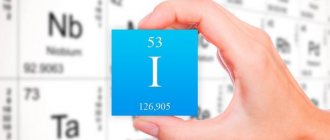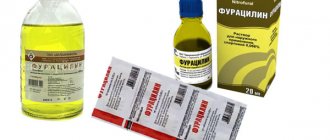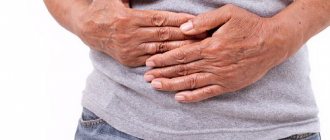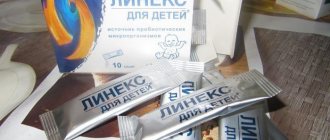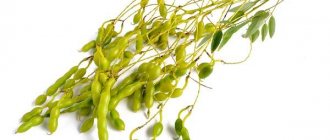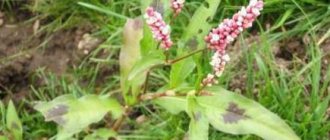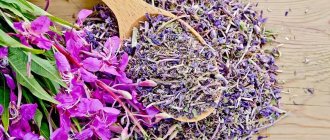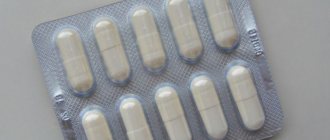Lugol's solution with glycerin is one of the popular traditional methods of treating various diseases. The drug, which is based on iodine, is considered an inexpensive and quite effective remedy.
Lugol's solution was developed by the French physician Jean Lugol in 1829. But it became popular during the disaster at the Chernobyl nuclear power plant, when it began to be actively used to reduce the absorption of radiation by the thyroid gland. The standard composition of the drug contains 1% iodine and 2% potassium iodide. Glycerin is used as a solvent, as it is a viscous substance, which makes the product thicker. Find out in more detail about the benefits and harms of Lugol's solution.
pharmachologic effect
Iodine has a pronounced antimicrobial effect . The active substance has a cauterizing effect in high concentrations. Small doses of elemental iodine have a local irritating effect. The principle of action is based on the ability of the active substance to precipitate tissue proteins. In terms of metabolism, iodine exhibits an increase in dissimilation processes. In patients with atherosclerosis, a decrease in the level of beta lipoproteins and cholesterol in the blood is recorded. The active substance can increase lipoproteinase and fibrinolytic activity of serum and slow down blood clotting .
The accumulation of iodine in syphilitic gums contributes to their softening and gradual resorption. At the same time, the accumulation of the active component in tuberculosis lesions enhances the inflammatory process. When the active substance is released by the excretory glands , there is an increase in secretion and irritation of the glandular tissues. In small doses, iodine enhances lactation and has an expectorant effect. At high iodine concentrations, suppression of lactation is recorded.
Solution for topical application Lugol solution with glycerin
Instructions for medical use of the drug
Description of pharmacological action
The main active ingredient is molecular iodine, which has an antiseptic and local irritant effect. It has a bactericidal effect against gram-negative and gram-positive flora, and also acts on pathogenic fungi (including yeast); Staphylococcus spp. more resistant to iodine, however, with long-term use of the drug, suppression of staphylococcal flora is observed in 80% of cases; Pseudomonas aeruginosa is resistant to the drug. When applied to large surfaces of the skin and mucous membranes, iodine has a resorptive effect: it participates in the synthesis of T3 and T4.
Indications for use
For external use: infectious and inflammatory skin lesions, injuries, wounds, myalgia. For local use: chronic tonsillitis, atrophic rhinitis, purulent otitis media, trophic and varicose ulcers, wounds, infected burns, fresh thermal and chemical burns of I-II degree. For oral administration: prevention and treatment of atherosclerosis, tertiary syphilis.
Release form
Solution for topical use 25 g - dark glass bottles (1) - cardboard packs. Solution for topical use 50 g - dark glass bottles (1) - cardboard packs.
Pharmacodynamics
Preparations that remove elemental iodine have a much less pronounced irritating effect, and iodides have local irritating properties only in very high concentrations. The nature of the resorptive effect of elemental iodine and iodides preparations is the same. During the resorptive effect, iodine preparations have the most pronounced effect on the functions of the thyroid gland. In case of iodine deficiency, iodides help restore impaired synthesis of thyroid hormones. With normal iodine content in the environment, iodides inhibit the synthesis of thyroid hormones, the sensitivity of the thyroid gland to pituitary TSH decreases and its secretion by the pituitary gland is blocked. The effect of iodine preparations on metabolism is manifested by increased dissimilation processes. In atherosclerosis, they cause a slight decrease in the concentration of cholesterol and beta-lipoproteins in the blood; in addition, they increase the fibrinolytic and lipoproteinase activity of blood serum and slow down the rate of blood clotting.
Pharmacokinetics
Upon contact with skin or mucous membranes, 30% is converted into iodides, and the rest into active iodine. Partially absorbed. The absorbed part penetrates tissues and organs and is selectively absorbed by the thyroid gland. It is secreted mainly by the kidneys, intestines, sweat and mammary glands.
Use during pregnancy
Contraindicated for oral administration during pregnancy.
Contraindications for use
Hypersensitivity to iodine. For oral administration - pulmonary tuberculosis, nephritis, nephrosis, adenomas (including the thyroid gland), furunculosis, acne, chronic pyoderma, hemorrhagic diathesis, urticaria, pregnancy, children under 5 years of age.
Side effects
For external use: rarely - skin irritation; with prolonged use on large wound surfaces - iodism (rhinitis, urticaria, Quincke's edema, salivation, lacrimation, acne). When taken orally: allergic skin reactions, tachycardia, nervousness, sleep disturbances, increased sweating, diarrhea (in patients over 40 years of age).
Directions for use and doses
When applied externally, iodine is used to treat damaged areas of the skin. For oral administration, the dose is set individually, depending on the indications and age of the patient. Topically used for washing lacunae and supratonsillar spaces - 4-5 procedures at intervals of 2-3 days, for irrigation of the nasopharynx - 2-3 times a week for 2-3 months, for instillation into the ear and rinsing - for 2-4 weeks; in surgical practice and for burns, gauze napkins applied to the affected surface are moistened as needed.
Overdose
Not described.
Interactions with other drugs
Pharmaceutically incompatible with essential oils, ammonia solutions, white sedimentary mercury (an explosive mixture is formed). An alkaline or acidic environment, the presence of fat, pus, and blood weaken the antiseptic activity. Reduces the hypothyroid and goitrogenic effects of lithium preparations.
Special instructions for use
With prolonged use, phenomena of iodism are possible.
Storage conditions
List B: In a cool, dark place.
Best before date
36 months
ATX classification:
R Respiratory system
R02 Preparations for the treatment of throat diseases
R02A Preparations for the treatment of throat diseases
R02AA Antiseptics
R02AA20 Other drugs
Indications for use
External use of Lugol's solution with Glycerin:
- wound lesions;
- infectious and inflammatory lesions of the skin;
- traumatic lesions;
- myalgia.
Locally the medication is used for:
- infected burns;
- atrophic rhinitis ;
- varicose ulcers;
- chronic tonsillitis;
- thermal burns;
- trophic ulcers;
- chemical burns.
Indications for oral administration:
- tertiary syphilis;
- atherosclerotic changes.
Interaction with other drugs
The medication must not be used in parallel with the following drugs:
- ammonia solutions;
- essential oils;
- sedimentary mercury (white).
If there is blood, purulent or fatty masses in the areas to be treated, then the antiseptic activity of the drug will be weakened.
With the parallel use of Lugol with lithium preparations, their goitrogenic and hypothyroid effects on the body will be weakened.
Contraindications
Lugol's solution is not prescribed for individual hypersensitivity to iodine. Contraindications for oral administration:
- furunculosis;
- thyroid adenoma;
- nephrosis, neuritis;
- pulmonary tuberculosis;
- carrying a pregnancy ;
- hemorrhagic diathesis;
- hives;
- chronic course of pyoderma.
Age limit – up to 5 years.
How to use the solution
At what age can Lugol be used in the treatment of children? Previously, Lugol was a viscous, thick liquid. It was inconvenient to treat the throat with such a solution. With the advent of the spray, this problem has resolved itself. But if the traditional Lugol's solution can be used for children from 6 months, then for sore throat or stomatitis, the spray is recommended to be used only for children over 5 years old, due to the structure of the spray cans and the toxicity of iodine.
The use of Lugol's is prescribed to a child for the treatment of oral diseases. For sore throat, the remedy is effective in the first days of infection, while in advanced cases of purulent form, Lugol is used as a secondary local remedy. And for stomatitis, it is recommended to smear the child’s wounds in the mouth.
Lugol can also be used in cases of burns, traumatic or other injuries (if wounds are present), during ulcers or purulent inflammations (helps pus to come out, freeing it from lacunae). In addition to Lugol's, regardless of age, antibiotics are prescribed to avoid disease progression.
Side effects
A solution with Glycerin when applied externally causes:
- lacrimation;
- Quincke's edema;
- rhinitis;
- acne;
- salivation;
- hives
When taken orally, Lugol's solution causes:
- hyperhidrosis;
- nervousness;
- diarrhea syndrome;
- insomnia;
- cardiopalmus.
If other negative reactions are registered, it is recommended to discontinue Lugol's solution.
Glycerin in cosmetics: why is it needed?
The cosmetics industry has not been left behind. And manufacturers of creams, lipsticks and other personal care products also include this substance in their products. But how can such a component benefit our skin?
Glycerin in cosmetics is used for:
- Skin moisturizing. As noted above, glycerin takes moisture from the environment and gives it to the skin. It is able to penetrate very deeply into the epidermis, saturating all its layers with moisture. There is only one warning: if the air is dry, glycerin will begin to draw water FROM the skin. And this already threatens you with dryness and other unpleasant sensations. To avoid such an undesirable effect, drink enough water and maintain constant air humidity of at least 65%. A humidifier, which can be purchased at any electronics and household appliances store, will help you with this.
- Protection. Glycerin creates a thin film on the face that locks in the moisture and beneficial substances contained in the cream, preventing them from evaporating.
- Mitigation. This liquid perfectly softens the skin, making it softer and velvety to the touch. If you have sensitive, irritated and dry skin, then regular soap should be replaced with glycerin soap. It will help relieve dryness, eliminate irritation and itching.
- Replenishing the lack of glycerol in cells. Our body also produces glycerol. It helps water circulate in cell membranes, helping to transport water into cells through special channels - aquaporins. Therefore, care products with glycerin must be used to ensure the correct course of this process.
- Care for dry hair and eliminate dandruff and itchy scalp. Thanks to their ability to retain moisture, shampoos, balms and masks with glycerin moisturize the hair and scalp well.
Instructions for use (Method and dosage)
Lugol's solution can be used externally to treat damaged skin. Dosing of the medication for internal use is carried out on an individual basis. Instructions for Lugol's solution with Glycerin for angina : locally, regularly rinse the supratonsillar spaces and lacunae for 5 days. How to smear the throat: treat with gauze swabs or cotton swabs. The solution for sore throat cannot be used twice. In surgical practice, the drug is used for burns. Directions for use: Apply a moistened gauze pad to the affected tissue 2-3 times a day. Lugol's ointment is not available.
Release form
In pharmacy chains, the drug is presented in the following pharmacological forms:
- Spray.
- Solution.
The medicine is packaged in bottles made of polymer raw materials and glass:
- Plastic. 15g, 25g, 30g, 40g, 50g.
- Glass. 25g, 30g, 40g, 50g, 60g, 70g, 80g, 100g.
- By type of dropper. The bottles are equipped with a sprayer, a dispenser, a spray nozzle, and a brush stick.
Analogs
Level 4 ATC code matches: Falimint
Suprima-ENT
Ingalipt-N
Strepsils Plus
Strepsils
Ingalipt
Theraflu LAR
Hexoral Tabs
Lisak
Efizol
Angilex
Kameton
Anzibel
Agisept
Yox
Lugol
Laripront
Stopangin 2A
Stopangin
Septolete Neo
- Malavit;
- Orasept;
- Stopangin;
- Angilex.
Pharmacokinetics
When Lugol comes into contact with the body, elemental iodine is partially absorbed and distributed throughout the body through the bloodstream, but is accumulated mainly by the thyroid gland. Excretion occurs through the skin with sweat, through the intestines or kidneys. A small portion of iodides is found in breast milk.
Spraying Lugol onto the mucous membranes of the throat, nose, and skin is safe in correctly calculated doses. The drug is low-toxic, its resorption when applied locally and externally is insignificant. High absorption is observed when the solution is swallowed.
Price of Lugol's solution, where to buy
The price of the medicine in Russia is 10-15 rubles. The cost of the drug in Ukraine (Lugol's roses with glycerin) is 3 UAH.
- Online pharmacies in RussiaRussia
- Online pharmacies in UkraineUkraine
ZdravCity
- Lugol's solution with glycerin for places.
approx. spray bottle 50g Samaramedprom OJSC 51 rub. order
Pharmacy Dialogue
- Lugol's solution with glycerin (50ml bottle with spray) MFF
51 RUR order
- Lugol's solution with glycerin (bottle 25g) Samaramedprom
12 RUR order
- Lugol's solution with glycerin (50 ml bottle with spray) Tula FF
74 RUR order
show more
Price
The cost of this medicine varies from 70 to 150 rubles.
The price is influenced by various factors, for example, the promotion of the pharmaceutical company that manufactures the drug, the release form, etc.
Do you want to know what are the instructions for using lidocaine in ampoules during pregnancy? Then you should follow the link and read the article. You can read where you can get an orthopantomogram at the following link.
You can read about which removable dentures are best to choose if you are partially missing teeth in our article.
Other types of Lugol's drug
Lugol's spray
In addition to liquid form, Lugol is available in spray form. It is produced by Russian and Lithuanian pharmaceutical factories. The composition of Lugol spray is similar to the liquid form: iodine, iodide and glycerin. It has the same effect and can be used as an alternative to a spray for respiratory diseases or infectious inflammation of the oral cavity.
Obviously, spraying a spray is easier than applying the solution with a cotton swab or brush. For this reason, a spray is chosen more often for throat diseases than a solution. On the other hand, it is more convenient to apply the solution to the oral mucosa for stomatitis and other diseases with similar localization.
Lugol spray Vialine
The spray under the trade name “Lugol Vialine” is produced and sold by a Ukrainian pharmacological company. Despite similar indications for use and scope of use, this drug is not related to traditional Lugol.
Instead of iodine, the antiseptic effect of the drug is provided by the antibiotic triclosan. There is nothing bad to say about triclosan. When applied topically, it is not absorbed. For this reason, it is widely used in the manufacture of cosmetic hygiene products, primarily soap and toothpaste.
Triclosan is effective not only against bacteria, but also against viruses, fungi, and parasitic microorganisms. As with other antibiotics, microbes can develop varying degrees of resistance to triclosan.
In this regard, Lugol with iodine certainly wins, because. it leads to unconditional coagulation of microbial proteins. Microorganisms cannot acquire resistance to the precipitating effects of iodine.
Overdose
Lugol's long-term use or one-time use in a high dose can provoke iodism.
The state of excessive accumulation of iodine in the body is accompanied by the following symptoms:
- increased salivation;
- constant thirst;
- runny nose, cough;
- itching, burning;
- rash, dry skin;
- metallic taste in the mouth;
- swelling;
- bronchospasm;
- nausea, vomiting.
If such symptoms appear, you should drink sorbents: potato starch, activated carbon. As an antidote, you can take soda diluted in water, milk, or jelly. If tachycardia, convulsions, a drop in blood pressure, or a threadlike pulse occur, you should immediately consult a doctor.

